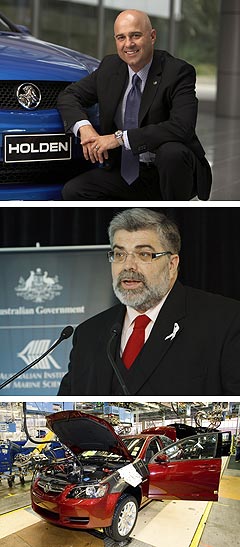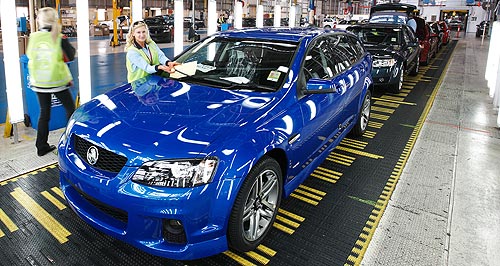Future models - Holden - CommodoreHolden to dress Commodore in aluminiumWeight-loss: Holden's next-generation VF Commodore will employ aluminium body panels to cut weight and improve fuel economy. Commodore to get aluminium panels and electric steering as Holden greens large car19 May 2011 HOLDEN will become the first Australian car manufacturer to employ mass-produced aluminium body panels – most likely the bonnet and boot – to snip the fuel consumption of its next-generation VF Commodore due in 2014. The “light-weighting” exercise, plus a switch to electric-powered steering and new efforts to improve the aerodynamics of the top-selling Australian car, are expected to cut Commodore’s thirst by about seven per cent at the cost of at least $160 million. A quarter of that bill – $39.8 million – will be paid by the federal government from its now defunct Green Car Innovation Fund, which was killed off early this year – a victim of spending cuts in the wake of the Queensland floods. GM Holden applied for the grant before Canberra brought down the boom on the fund, becoming one of several companies to have applications honoured by federal innovation and industry minister Senator Kim Carr. The fresh grant to Holden, announced today by Senator Carr at Holden’s factory in South Australia, brings the total hand-outs to Holden from the fund to $189 million – more than half of the $340 million dished out to car companies and automotive component suppliers to date.  From top: GM Holden chairman and managing director Mike Devereux, federal innovation and industry minister Senator Kim Carr, production at Holden's Elizabeth plant. From top: GM Holden chairman and managing director Mike Devereux, federal innovation and industry minister Senator Kim Carr, production at Holden's Elizabeth plant.The previous $149 million grant to Holden was to help bring the Cruze small car into local production alongside the Commodore and its derivatives at the factory at Elizabeth, in Adelaide’s north. Mr Carr said the Commodore project would help to create 250 new engineering jobs at Holden – for a total of 440 engineers – and underpin 4500 jobs in total at the company. He said the new technology would have a knock-on effect across Holden’s operations, with improvements expected to extend to Holden’s other Australian-made product, the Cruze. Holden executives have long been hinting that they would make cutting the weight of its next Commodore a priority to help reduce the Commodore’s fuel consumption. A seven per cut would reduce the current 9.1L/100km for the petrol 3.0-litre SIDI V6 variant’s fuel consumption to about 8.4 litres per 100km, while the 3.6 litre V6’s combined fuel rating should fall from about 9.8L/100km to about 9.1L/100km. GM Holden chairman and managing director Mike Devereux told GoAuto today that Holden wanted to make sure the next generation Commodore would continue to be relevant to Australian consumers. He said the grant would be matched on a three-dollar to one-dollar basis by Holden in engineering the new car and upgrading production facilities at Elizabeth to produce the aluminium panels. “We will be using that money to bring a number of innovations that are going to drive pretty significant fuel savings and carbon emission reductions,” he aid. “We are talking about aluminium panels on the car and some significant aero work on the vehicle as well. “We are not actually announcing for competitive reasons much beyond that, but it is a pretty exciting day because it keeps the story going on Commodore’s future and its relevance to Australia.” Asked if the use of aluminium would have a cost impact on Commodore, Mr Devereux said: “We have got a pretty good balance of what the car needs to cost, but we also understand that we want people to enjoy the benefits of a large car, but do it more sustainably and have a smaller footprint.” Mr Devereux conceded that aluminium was a more difficult material than traditional steel for car panels, but said Holden already had a good handle on the technology. “Aluminium is a pretty hi-tech material to use on body panels,” he said. “It does obviously give you significant savings in mass. “It is difficult to stamp – it isn’t easy. So the shapes are difficult, but we have got a really good engineering team that has it under control.” At least 30 car companies are already using aluminium panels on cars to cut weight, with savings of up to 50 per cent compared on comparable steel panels, although they are mostly applied to high-end vehicles that can cope with the extra cost. Holden’s American sister companies Cadillac and Chevrolet both already use aluminium panels on some cars, mainly on bonnets on luxury cars such as the Cadillac CTS and Seville and SUV rear hatches on vehicles such as the Chevrolet Tahoe. Australia’s CSIRO is a leading researcher into aluminium technologies, but Mr Devereux declined to say if any third parties were involved in the development project. Holden’s VF Commodore is expected to remain rear-wheel drive, built on a modified version of the current VE Zeta platform. While most of the body – including the critical safety cell – will continue to be made of steel, aluminium will be applied to some large surface panels such as the bonnet. Mr Devereux declined to say if the new Commodore would also mark the introduction of electrified powertrains – such as hybrid technology – saying: “We are really trying to say as little as possible for competitive reasons so we don’t tip our hand.” He was also diplomatic on the proposed introduction of the federal carbon tax in the presence of Senator Carr and while the industry is still arguing its case with Canberra. “The good thing is that the industry is fully engaged with the government in understanding what the plan is and trying to negotiate what I would say is a rational approach,” he said. “So I really don’t have much to say about its impact because I don’t know what the program will be.” Although Holden did not mention electric-power-assisted steering (EPAS) in its media release on the Commodore grant, GoAuto understands that will be included in the package of fuel-saving measures. According to Senator Carr, those measures will include other technologies “that can’t be mentioned for confidential reasons”. EPAS helps to save fuel by eliminating the power steering pump used in hydraulic power steering assistance, thus cutting the drag on the petrol engine. That move would bring the next Commodore into line with the just-released Ford Territory and facelifted Ford Falcon, which is due later this year. The Holden Commodore has been the best-selling car in Australia for 15 years, although it has been knocked off its perch in some months by other vehicles such as the Toyota Corolla and Toyota HiLux. This year, sales of the big Holden are down 5.6 per cent in an overall market down 3.2 per cent. The big Holden dominates the large car segment, holding 56.9 per cent year to date, compared with long-time rival Falcon on 34.5 per cent.  Read moreCommodore pricing
Motor industry news |
Click to shareHolden modelsCommodore pricing
Motor industry news |















Facebook Twitter Instagram